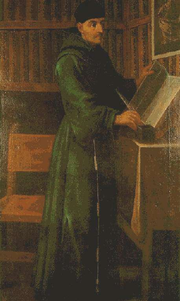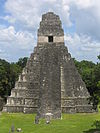Portal:Mesoamerica
Mesoamerica (Spanish: Mesoamérica) is a region and cultural area in the Americas, extending approximately from central Mexico to Belize, Guatemala, El Salvador, Honduras, Nicaragua, and Costa Rica, within which a number of pre-Columbian societies flourished before the Spanish colonization of the Americas in the 15th and 16th centuries.
As a cultural area, Mesoamerica is defined by a mosaic of cultural traits developed and shared by its indigenous cultures. Beginning as early as 7000 BC the domestication of maize, beans, squash and chili, as well as the turkey and dog, caused a transition from paleo-Indian hunter-gatherer tribal grouping to the organization of sedentary agricultural villages. In the subsequent formative period, agriculture and cultural traits such as a complex mythological and religious tradition, a vigesimal numeric system, and a complex calendric system, a tradition of ball playing, and a distinct architectural style, were diffused through the area. Also in this period villages began to become socially stratified and develop into chiefdoms with the development of large ceremonial centers, interconnected by a network of trade routes for the exchange of luxury goods such as obsidian, jade, cacao, cinnabar, Spondylus shells, hematite, and ceramics. While Mesoamerican civilization did know of the wheel and basic metallurgy, neither of these technologies became culturally important.
Among the earliest complex civilizations was the Olmec culture which inhabited the Gulf coast of Mexico. In the Preclassic period, complex urban polities began to develop among the Maya and the Zapotecs. During this period the first true Mesoamerican writing systems were developed in the Epi-Olmec and the Zapotec cultures, and the Mesoamerican writing tradition reached its height in the Classic Maya Hieroglyphic script. Mesoamerica is one of only five regions of the world where writing was independently developed. In Central Mexico, the height of the Classic period saw the ascendancy of the city of Teotihuacan, which formed a military and commercial empire whose political influence stretched south into the Maya area and northward. During the Epi-Classic period the Nahua peoples began moving south into Mesoamerica from the North. During the early post-Classic period Central Mexico was dominated by the Toltec culture, Oaxaca by the Mixtec, and the lowland Maya area had important centers at Chichén Itzá and Mayapán. Towards the end of the post-Classic period the Aztecs of Central Mexico built a tributary empire covering most of central Mesoamerica.
Selected article

The Mesoamerican ballgame or ōllamaliztli (hispanized as Ulama) in Nahuatl was a sport with ritual associations played since 1,400 B.C. by the pre-Columbian peoples of Ancient Mexico and Central America. The sport had different versions in different places during the millennia, and a modern version of the game, ulama, is still played in a few places by the local indigenous population.
The rules of the ballgame are not known, but judging from its descendant, ulama, they were probably similar to racquetball, where the aim is to keep the ball in play. The stone ballcourt goals (see photo to right) are a late addition to the game.
In the most widespread version of the game, the players struck the ball with their hips, although some versions allowed the use of forearms, rackets, bats, or handstones. The ball was made of solid rubber and weighed as much as 4 kg (9 lbs), and sizes differed greatly over time or according to the version played.
The game had important ritual aspects, and major formal ballgames were held as ritual events, often featuring human sacrifice. The sport was also played casually for recreation by children and perhaps even women.
Pre-Columbian ballcourts have been found throughout Mesoamerica, as far south as Nicaragua, and possibly as far north as the now U.S. state of Arizona. These ballcourts vary considerably in size, but all have long narrow alleys with side-walls against which the balls could bounce.
Selected biography

Bernardino de Sahagún (1499 – October 23, 1590) was a Franciscan friar, missionary priest and pioneering ethnographer who participated in the Catholic evangelization of colonial New Spain (now Mexico). Born in Sahagún, Spain, in 1499, he journeyed to New Spain in 1529, and spent more than 50 years conducting interviews regarding Aztec beliefs, culture and history. Though he primarily dedicated himself to the missionary task, his extraordinary work documenting indigenous worldview and culture has earned him the title “the first anthropologist.” He also contributed to the description of the Aztec language Nahuatl, into which he translated the Psalms, the Gospels and a basic manual of religious education.
Sahagún is perhaps best known as the author of Historia general de las cosas de la Nueva España (in English: General History of the Things of New Spain (hereinafter referred to as Historia General). The most famous extant manuscript of the Historia General is the Florentine Codex. It consists of 2400 pages organized into twelve books with approximately 2,000 illustrations drawn by native artists using European techniques. The text in Spanish and Nahuatl documents the culture, religious cosmology (worldview), ritual practices, society, economics, and history of the Aztec people. In the process of putting together the Historia general, Bernardino pioneered new methods for gathering ethnographic information and validating its accuracy. The Historia general has been called “one of the most remarkable accounts of a non-Western culture ever composed,” and Bernardino has been called the father of American ethnography.
Did you know?
- ... that Temple I (pictured), in the Maya ruins of Tikal in Guatemala, is a 47-metre (154 ft) high funerary monument dedicated to king Jasaw Chan K'awiil I who died in AD 734?
- ... that the Spanish conquest of Guatemala was a prolonged conflict against the Maya that lasted nearly two hundred years?
Subcategories
Related portals
Selected image
 |
Acatitlan (Nahuatl: "place among the reeds"; Spanish "carrizal") is an early Aztec archaeological site located in the municipality of Tlalnepantla de Baz in Mexico. In pre-Hispanic times it was located on the northwest shore of Lake Texcoco. Acatitlan declined after the Spanish conquest of Mexico and the city was destroyed so its stone could be used to construct Christian churches.
Featured articles
Good Topics
Good articles
 Gómez de Alvarado
Gómez de Alvarado Aztecs
Aztecs La Blanca, Peten
La Blanca, Peten Calakmul
Calakmul Bartolomé de las Casas
Bartolomé de las Casas Copán
Copán El Chal
El Chal Haʼ Kʼin Xook
Haʼ Kʼin Xook Itzam Kʼan Ahk II
Itzam Kʼan Ahk II Iximche
Iximche Kʼinich Yat Ahk II
Kʼinich Yat Ahk II Kʼinich Yoʼnal Ahk I
Kʼinich Yoʼnal Ahk I Macuahuitl
Macuahuitl Maize
Maize Manche Chʼol
Manche Chʼol Mixco Viejo
Mixco Viejo Motul de San José
Motul de San José Mundo Perdido, Tikal
Mundo Perdido, Tikal North Acropolis, Tikal
North Acropolis, Tikal Potbelly sculpture
Potbelly sculpture William H. Prescott
William H. Prescott Qʼumarkaj
Qʼumarkaj Resplendent quetzal
Resplendent quetzal Seibal
Seibal Serpent labret with articulated tongue
Serpent labret with articulated tongue Spanish conquest of Yucatán
Spanish conquest of Yucatán Spanish conquest of Chiapas
Spanish conquest of Chiapas Spanish conquest of El Salvador
Spanish conquest of El Salvador Spanish conquest of Honduras
Spanish conquest of Honduras Spanish conquest of the Maya
Spanish conquest of the Maya Tikal
Tikal Toniná
Toniná Western Mexico shaft tomb tradition
Western Mexico shaft tomb tradition Benjamin Lee Whorf
Benjamin Lee Whorf Yoʼnal Ahk III
Yoʼnal Ahk III Zaculeu
Zaculeu
Topics
WikiProjects
New articles
Rules | Match log | Results page (for watching) | Last updated: 2024-05-08 21:09 (UTC)
Note: The list display can now be customized by each user. See List display personalization for details.
- Results of the 2012 Ukrainian parliamentary election in the foreign electoral district (edit | talk | history | links | watch | logs | tools) by Lastjourneyman. (talk · contribs · new pages (2)) started on 2024-05-05, score: 24
- The Stag and the Vine (edit | talk | history | links | watch | logs | tools) by Sweetpool50 (talk · contribs · new pages (3)) started on 2024-05-05, score: 24
- Cardamine occulta (edit | talk | history | links | watch | logs | tools) by Abductive (talk · contribs · new pages (37)) started on 2024-05-05, score: 32
- Rotundanthus (edit | talk | history | links | watch | logs | tools) by Tom Radulovich (talk · contribs · new pages (137)) started on 2024-05-04, score: 60
- Rosa Elena Curruchich (edit | talk | history | links | watch | logs | tools) by Netherzone (talk · contribs · new pages (9)) started on 2024-05-01, score: 28
- Caritas Mexico (edit | talk | history | links | watch | logs | tools) by Bdx (talk · contribs · new pages (36)) started on 2024-05-01, score: 54
- Emil’ Keme (edit | talk | history | links | watch | logs | tools) by Lvarelamejia (talk · contribs · new pages (1)) started on 2024-04-30, score: 70
- List of African American poets (edit | talk | history | links | watch | logs | tools) by Omnis Scientia (talk · contribs · new pages (10)) started on 2024-04-30, score: 28
- Timeline of the 1993 Atlantic hurricane season (edit | talk | history | links | watch | logs | tools) by Dylan620 (talk · contribs · new pages (3)) started on 2024-04-30, score: 42
- Landy Párraga (edit | talk | history | links | watch | logs | tools) by Lmpesantezt (talk · contribs · new pages (3)) started on 2024-04-29, score: 28
- Battle of San Salvador (1823) (edit | talk | history | links | watch | logs | tools) by Larissæ (talk · contribs · new pages (5)) started on 2024-04-27, score: 26
- Exponi nobis (edit | talk | history | links | watch | logs | tools) by Moriwen (talk · contribs · new pages (359)) started on 2024-04-27, score: 28
- Raclin Murphy Museum of Art (edit | talk | history | links | watch | logs | tools) by Odecalchi (talk · contribs · new pages (1)) started on 2024-04-27, score: 58
- Anacleto's rebellion (edit | talk | history | links | watch | logs | tools) by Larissæ (talk · contribs · new pages (5)) started on 2024-04-25, score: 24
- Battle of San Salvador (1822) (edit | talk | history | links | watch | logs | tools) by Larissæ (talk · contribs · new pages (5)) started on 2024-04-25, score: 40
Associated Wikimedia
The following Wikimedia Foundation sister projects provide more on this subject:
-
Commons
Free media repository -
Wikibooks
Free textbooks and manuals -
Wikidata
Free knowledge base -
Wikinews
Free-content news -
Wikiquote
Collection of quotations -
Wikisource
Free-content library -
Wikiversity
Free learning tools -
Wiktionary
Dictionary and thesaurus

























